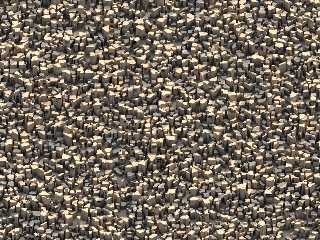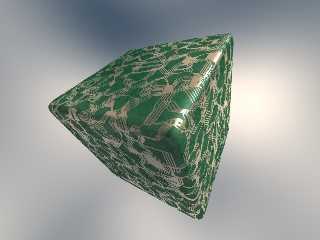 |
 |
|
 |
|
 |
|  |
|  |
|
 |
|
 |
|  |
|  |
|
 |
I've been messing around with the crackle pigment, and got a couple of good
effects :)
The first one's an iso surface that looks a bit like a city. It looks more
city-like from a low camera angle, but I did this orthographic view to use a s a
desktop backdrop :) BTW, this one took nearly 24 hours to render!! I'm gonna
have to find a way to speed it up.
The other picture's a circuit board pigment effect I dreamt up a couple of hours
ago. Both use crackle with metric 1 to get that nice angular effect.
What do you think?
--
Tek
http://www.evilsuperbrain.com
Post a reply to this message
Attachments:
Download 'crackscape.jpg' (173 KB)
Download 'crackcircuit.jpg' (54 KB)
Preview of image 'crackscape.jpg'

Preview of image 'crackcircuit.jpg'

|
 |
|  |
|  |
|
 |
|
 |
|  |
|  |
|
 |
Hi Tek, I especially like the circuit board and I have no idea how you made
it with crackle patterns! I would have needed a bitmap.. But you know, if
you send electricity through this, you'll get nothing but shortcuts.. Can
this be avoided / improved? Good work, anyway.
Regards,
Hugo
Post a reply to this message
|
 |
|  |
|  |
|
 |
|
 |
|  |
|  |
|
 |
I think you mean 'short circuits', not 'shortcuts'. Of course, from an
electron's point of view, it's the same thing.. but you weren't talking from
an electron's perspective.. *walks away muttering*
"Hugo" <hua### [at] post3 tele tele dk> wrote in message
news:3c8bc3a4$1@news.povray.org...
> Hi Tek, I especially like the circuit board and I have no idea how you
made
> it with crackle patterns! I would have needed a bitmap.. But you know, if
> you send electricity through this, you'll get nothing but shortcuts.. Can
> this be avoided / improved? Good work, anyway.
>
> Regards,
> Hugo
>
> dk> wrote in message
news:3c8bc3a4$1@news.povray.org...
> Hi Tek, I especially like the circuit board and I have no idea how you
made
> it with crackle patterns! I would have needed a bitmap.. But you know, if
> you send electricity through this, you'll get nothing but shortcuts.. Can
> this be avoided / improved? Good work, anyway.
>
> Regards,
> Hugo
>
>
Post a reply to this message
|
 |
|  |
|  |
|
 |
|
 |
|  |
|  |
|
 |
> I think you mean 'short circuits', not 'shortcuts'.
?? Sorry hmm.. I really thought this was the proper way to say it in
english. Then how to say "when something short circuits" ...you don't say
that, or?
Post a reply to this message
|
 |
|  |
|  |
|
 |
|
 |
|  |
|  |
|
 |
I like the first one best, a desktop for one day. After more than a day, my
eyes will probably start to malfunction.
It makes me think of a kind of rock call basalt (at lease in Dutch, I am
not sure what it is in English).
Post a reply to this message
|
 |
|  |
|  |
|
 |
|
 |
|  |
|  |
|
 |
Tek wrote:
> I've been messing around with the crackle pigment, and got a couple
> of good effects :)
Very nice, both of them. Any chance of getting the source?
--
/"\ | iki.
\ / ASCII Ribbon Campaign | fi/
X Against HTML Mail | zds
/ \
Post a reply to this message
|
 |
|  |
|  |
|
 |
|
 |
|  |
|  |
|
 |
Theo said
> It makes me think of a kind of rock call basalt (at lease in Dutch, I
> am not sure what it is in English).
>
Same thing.
--
Gis poste, Arto.
Post a reply to this message
|
 |
|  |
|  |
|
 |
|
 |
|  |
|  |
|
 |
Tek wrote:
>
> I've been messing around with the crackle pigment, and got a couple of good
> effects :)
>
> The first one's an iso surface that looks a bit like a city. It looks more
> city-like from a low camera angle, but I did this orthographic view to use a s a
> desktop backdrop :) BTW, this one took nearly 24 hours to render!! I'm gonna
> have to find a way to speed it up.
You will always have serious problems with such infinite gradient
functions. There are no strongly visible artefacts at this scale, but in
a more detailed view you will surely see them.
Using conventional objects instead, preferably meshes, would be much more
efficient.
See for example:
http://www.interq.or.jp/blue/kawashu/include/i04.html
http://news.povray.org/povray.binaries.images/12339/
Christoph
--
POV-Ray tutorials, IsoWood include,
TransSkin and more: http://www.tu-bs.de/~y0013390/
Last updated 21 Feb. 2002 _____./\/^>_*_<^\/\.______
Post a reply to this message
|
 |
|  |
|  |
|
 |
|
 |
|  |
|  |
|
 |
In article <3c8bcda8@news.povray.org>,
Theo <Theo <the### [at] kabelfoon nl>> wrote:
> I like the first one best, a desktop for one day. After more than a day, my
> eyes will probably start to malfunction.
> It makes me think of a kind of rock call basalt (at lease in Dutch, I am
> not sure what it is in English).
It is called basalt in English as well. However, it usually takes the
form of hexagonal pillars, these are too irregular. This looks like more
of an organic phenomenon.
--
Christopher James Huff <chr### [at] mac nl>> wrote:
> I like the first one best, a desktop for one day. After more than a day, my
> eyes will probably start to malfunction.
> It makes me think of a kind of rock call basalt (at lease in Dutch, I am
> not sure what it is in English).
It is called basalt in English as well. However, it usually takes the
form of hexagonal pillars, these are too irregular. This looks like more
of an organic phenomenon.
--
Christopher James Huff <chr### [at] mac com>
POV-Ray TAG e-mail: chr### [at] tag com>
POV-Ray TAG e-mail: chr### [at] tag povray povray org
TAG web site: http://tag.povray.org/ org
TAG web site: http://tag.povray.org/
Post a reply to this message
|
 |
|  |
|  |
|
 |
|
 |
|  |
|  |
|
 |
Christoph Hormann schrieb in Nachricht <3C8BD3C2.7F80B4CE@gmx.de>...
>You will always have serious problems with such infinite gradient
>functions. There are no strongly visible artefacts at this scale, but in
>a more detailed view you will surely see them.
Hi Christoph,
Of course I have limited experience, but the problem seems not that big as
it first appears. There is that adaptive gradient method R. Suzuki mentioned
once (where? Don't know - had something to do with the old "eval" IIRC.) and
functions like min(min(abs(x),abs(y)),abs(z))) work quite well with there
infinite gradient and even with low max_gradient settings.
There are problems with the gradient of course and using pigments or
functions in isosurfaces will sometimes need some high max_gradient
settings. But I use them all the time and I had no problems, I could not
solve with some decent settings - even with the really 'evil' brick-pattern,
which is hard to use in isosurfaces.
Perhaps your experience is different, but IMHO pattern/pigment-functions are
very suitable esp. for isosurface beginners.
Greetings,
Marc-Hendrik
Post a reply to this message
|
 |
|  |
|  |
|
 |
|
 |
|  |




![]()